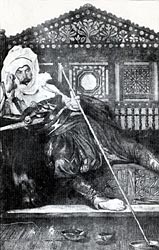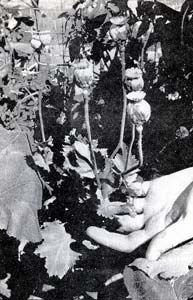Opium Poppy Cultivation, by John W. Allen
The lore of the Opium Poppy can be traced back to the oldest records of human history. Originally, the plant was native tot he Eastern Mediterranean. It was domesticated and spread throughout Europe during the Neolithic Age. Ancient texts on herbalism, referring to poppy tea, document the plant's usage during this time period.
 Opium was well known to the Greek, Roman, Mesopotamian and Assyrian cultures. Amazingly, it was unknown in ancient China and India. Opium's popularity in these countries is a comparatively recent development. Full knowledge of the opium poppy first reached Asia in about the fifteenth century A.S., where in a short time it became the drug of choice for millions of people (400 million Asians can't be wrong).
Opium was well known to the Greek, Roman, Mesopotamian and Assyrian cultures. Amazingly, it was unknown in ancient China and India. Opium's popularity in these countries is a comparatively recent development. Full knowledge of the opium poppy first reached Asia in about the fifteenth century A.S., where in a short time it became the drug of choice for millions of people (400 million Asians can't be wrong).
The method of smoking opium in China and India requires equipment consisting of a pipe, lamp, stylet and headrest. A hit of opium is placed on the tip of the stylet and roasted over the lamp until dry. It is then plunged into the pipe and heated while the smoker inhales deeply until stoned enough to fall back onto the headrest. The process is repeated as necessary to keep the headrest in full usage.
Opium can also be eaten. In fact, eating it is a more efficient method of ingestion than smoking. When burned, many of the active alkaloids are partially destroyed in combustion or lost in vapor. When eaten, virtually 100% of these alkaloids enter the body. Although some are removed by the liver and do not get a chance to produce their effects, the amount of psychoactives reaching the bloodstream is sufficient to produce an effect that is dramatically greater than would be realized by smoking the same quantity.
To consume by mouth, simply roll up a small ball, swallow and enjoy. You may wish to chew the opium prior to swallowing, if you can stand the horrible taste. Chewing and dissolving the substance in your mouth will cause it to enter the system faster and therefore result in a more intense effect.
The active alkaloids of opium are morphine and codeine. There are many other substances present that are used in medicine; however, they are found in opium only in trace quantities and generally do not produce any effect.
 All poppies produce a milky juice, but only papaver somniferum and its relative, Papaver setigerum, produce any morphine alkaloids. Papaver setigerum is an obscure wild plant and is not used for either legal or illegal opium production.
All poppies produce a milky juice, but only papaver somniferum and its relative, Papaver setigerum, produce any morphine alkaloids. Papaver setigerum is an obscure wild plant and is not used for either legal or illegal opium production.
Papaver somniferum (the sleep-bearing poppy) is the true opium poppy. It can be recognized by several distinct features. The foliage is a whitish dull green color, called glaucous.
The plant itself has a main stem, ending in a large flower or pod and side branches that end in smaller flowers or pods. When grown under good conditions, the poppy is three or four feet in height. It is an annual, that is, it completes its life cycle in one year.
Another method of identification is a chemical test. this is the most positive test since the plant contains morphine in all its parts; even the small seedlings contain morphine. Contrary to popular belief, the flowers are seldom pure white and may be violet, pink, white, red, or any combination of these colors. The color of the flower has no effect on the morphine content of the plant.
Many older homes have opium poppies growing in their gardens, as this plant was very popular for its lovely flowers, until its cultivation was outlawed in 1942. A midnight raid of your city's classic neighborhoods can be a very profitable pastime. Make sure the prospective booty is really the opium poppy. Use some daylight surveillance for identification purposes. Be cautious. Although most local police officers do not know what an opium poppy looks like, they may become suspicious of someone who is slashing or uprooting flowers in an old lady's yard.
[ Back ] [ Index ] [ Next ]
© 2000 John W. Allen & Erowid.org
 Opium was well known to the Greek, Roman, Mesopotamian and Assyrian cultures. Amazingly, it was unknown in ancient China and India. Opium's popularity in these countries is a comparatively recent development. Full knowledge of the opium poppy first reached Asia in about the fifteenth century A.S., where in a short time it became the drug of choice for millions of people (400 million Asians can't be wrong).
Opium was well known to the Greek, Roman, Mesopotamian and Assyrian cultures. Amazingly, it was unknown in ancient China and India. Opium's popularity in these countries is a comparatively recent development. Full knowledge of the opium poppy first reached Asia in about the fifteenth century A.S., where in a short time it became the drug of choice for millions of people (400 million Asians can't be wrong).The method of smoking opium in China and India requires equipment consisting of a pipe, lamp, stylet and headrest. A hit of opium is placed on the tip of the stylet and roasted over the lamp until dry. It is then plunged into the pipe and heated while the smoker inhales deeply until stoned enough to fall back onto the headrest. The process is repeated as necessary to keep the headrest in full usage.
Opium can also be eaten. In fact, eating it is a more efficient method of ingestion than smoking. When burned, many of the active alkaloids are partially destroyed in combustion or lost in vapor. When eaten, virtually 100% of these alkaloids enter the body. Although some are removed by the liver and do not get a chance to produce their effects, the amount of psychoactives reaching the bloodstream is sufficient to produce an effect that is dramatically greater than would be realized by smoking the same quantity.
To consume by mouth, simply roll up a small ball, swallow and enjoy. You may wish to chew the opium prior to swallowing, if you can stand the horrible taste. Chewing and dissolving the substance in your mouth will cause it to enter the system faster and therefore result in a more intense effect.
The active alkaloids of opium are morphine and codeine. There are many other substances present that are used in medicine; however, they are found in opium only in trace quantities and generally do not produce any effect.
 All poppies produce a milky juice, but only papaver somniferum and its relative, Papaver setigerum, produce any morphine alkaloids. Papaver setigerum is an obscure wild plant and is not used for either legal or illegal opium production.
All poppies produce a milky juice, but only papaver somniferum and its relative, Papaver setigerum, produce any morphine alkaloids. Papaver setigerum is an obscure wild plant and is not used for either legal or illegal opium production.Papaver somniferum (the sleep-bearing poppy) is the true opium poppy. It can be recognized by several distinct features. The foliage is a whitish dull green color, called glaucous.
The plant itself has a main stem, ending in a large flower or pod and side branches that end in smaller flowers or pods. When grown under good conditions, the poppy is three or four feet in height. It is an annual, that is, it completes its life cycle in one year.
Another method of identification is a chemical test. this is the most positive test since the plant contains morphine in all its parts; even the small seedlings contain morphine. Contrary to popular belief, the flowers are seldom pure white and may be violet, pink, white, red, or any combination of these colors. The color of the flower has no effect on the morphine content of the plant.
Many older homes have opium poppies growing in their gardens, as this plant was very popular for its lovely flowers, until its cultivation was outlawed in 1942. A midnight raid of your city's classic neighborhoods can be a very profitable pastime. Make sure the prospective booty is really the opium poppy. Use some daylight surveillance for identification purposes. Be cautious. Although most local police officers do not know what an opium poppy looks like, they may become suspicious of someone who is slashing or uprooting flowers in an old lady's yard.
© 2000 John W. Allen & Erowid.org

